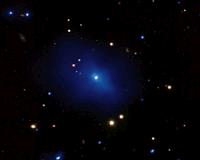 |
Huntsville AL (SPX) Nov 02, 2010 NASA's Chandra X-ray Observatory has observed an unusual galaxy cluster that contains a bright core of relatively cool gas surrounding a quasar called 3C 186. This is the most distant such object yet observed, and could provide insight into the triggering of quasars and the growth of galaxy clusters. This composite image of the cluster surrounding 3C 186 includes a new, deep image from Chandra (blue) showing emission from gas surrounding the point-like quasar near the center of the cluster. Chandra X-ray spectra show that the temperature of the gas drops from 80 million degrees on the outskirts of the cluster down to 30 million in the core. This drop in temperature occurs because intense X-ray emission from the gas cools it. Optical data from the Gemini telescope in yellow show the stars and galaxies in the field of view. What makes this particular galaxy cluster and its strong cooling core interesting is its age. 3C 186 is about 8 billion light years away from Earth, making it the most distant known galaxy cluster to contain a prominent cooling core. Because of its large distance the cluster is being seen when the Universe is relatively young, at less than half its current age. Previous observations have revealed large numbers of clusters with strong cooling cores at smaller distances from the Earth, less than about 6 billion light years. Far fewer, however, have been found at larger distances between 6 and 8 billion light years. Considering its young age this "precocious" galaxy cluster around 3C 186 appears to be surprisingly well formed. One explanation why fewer cooling cores are seen at larger distances is that these younger clusters experience higher rates of merging with other clusters or galaxies. These mergers would destroy the cooling cores. When coupled with the fact that it takes cooling cores a long time to form, this would make them rare in the earlier stages of the Universe. Since this cluster was only found serendipitously through a Chandra survey of a small sample of radio sources, it is possible that many more similar objects exist at large distances. If these are discovered, it may revise our understanding of how galaxy clusters developed during this period of the Universe's history. This galaxy cluster is also the most distant ever seen to contain a quasar. Only one other galaxy cluster containing a bright quasar has had a detailed study of its X-ray emitting gas, and this is located much closer to the Earth than 3C 186. In principle, the cooling gas near 3C 186 can provide enough fuel to support the growth of the supermassive black hole, the power source for the quasar. This object also provides an interesting chance to study the effects of a quasar within a galaxy cluster environment. The energy generated by the black hole can be released into the cluster not just via mechanical power in a jet, but also by radiation from the bright quasar. This might result in a powerful wind that heats the surrounding gas and prevents further cooling. The cluster is likely to be an ancestor of well-known nearby clusters such as Perseus and MS 0735.6+7421, where jets powered by the central black hole are boring out cavities in the cluster gas. It is much more distant and younger than these other two clusters and the radio source associated with 3C 186 is smaller and younger than in Perseus and MS 0735.6+7421. The paper describing these results is published in the October 10th issue of the Astrophysical Journal. The list of authors is Aneta Siemiginowska, Douglas Burke and Thomas Aldcroft from the Harvard Smithsonian Center for Astrophysics, Diana Worrall from the University of Bristol, UK, Steve Allen from the Kavli Institute for Particle Astrophysics and Cosmology at Stanford University, Jill Bechtold from the University of Arizona, and Tracy Clarke and Teddy Cheung from the Naval Research Laboratory. NASA's MSFC in Huntsville, Ala., manages the Chandra program for NASA's Science Mission Directorate in Washington. The Smithsonian Astrophysical Observatory controls Chandra's science and flight operations from Cambridge, Mass.
Share This Article With Planet Earth
Related Links Chandra X-ray Observatory Stellar Chemistry, The Universe And All Within It
 Galaxy Cluster, Quasar 3C 186
Galaxy Cluster, Quasar 3C 186Huntsville AL (SPX) Oct 28, 2010 NASA's Chandra X-ray Observatory has observed an unusual galaxy cluster that contains a bright core of relatively cool gas surrounding a quasar called 3C 186. This is the most distant such object yet observed, and could provide insight into the triggering of quasars and the growth of galaxy clusters. This composite image of the cluster surrounding 3C 186 includes a new, deep image from Cha ... read more |
|
| The content herein, unless otherwise known to be public domain, are Copyright 1995-2010 - SpaceDaily. AFP and UPI Wire Stories are copyright Agence France-Presse and United Press International. ESA Portal Reports are copyright European Space Agency. All NASA sourced material is public domain. Additional copyrights may apply in whole or part to other bona fide parties. Advertising does not imply endorsement,agreement or approval of any opinions, statements or information provided by SpaceDaily on any Web page published or hosted by SpaceDaily. Privacy Statement |